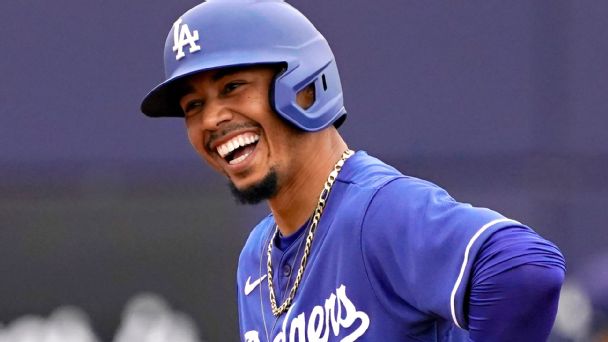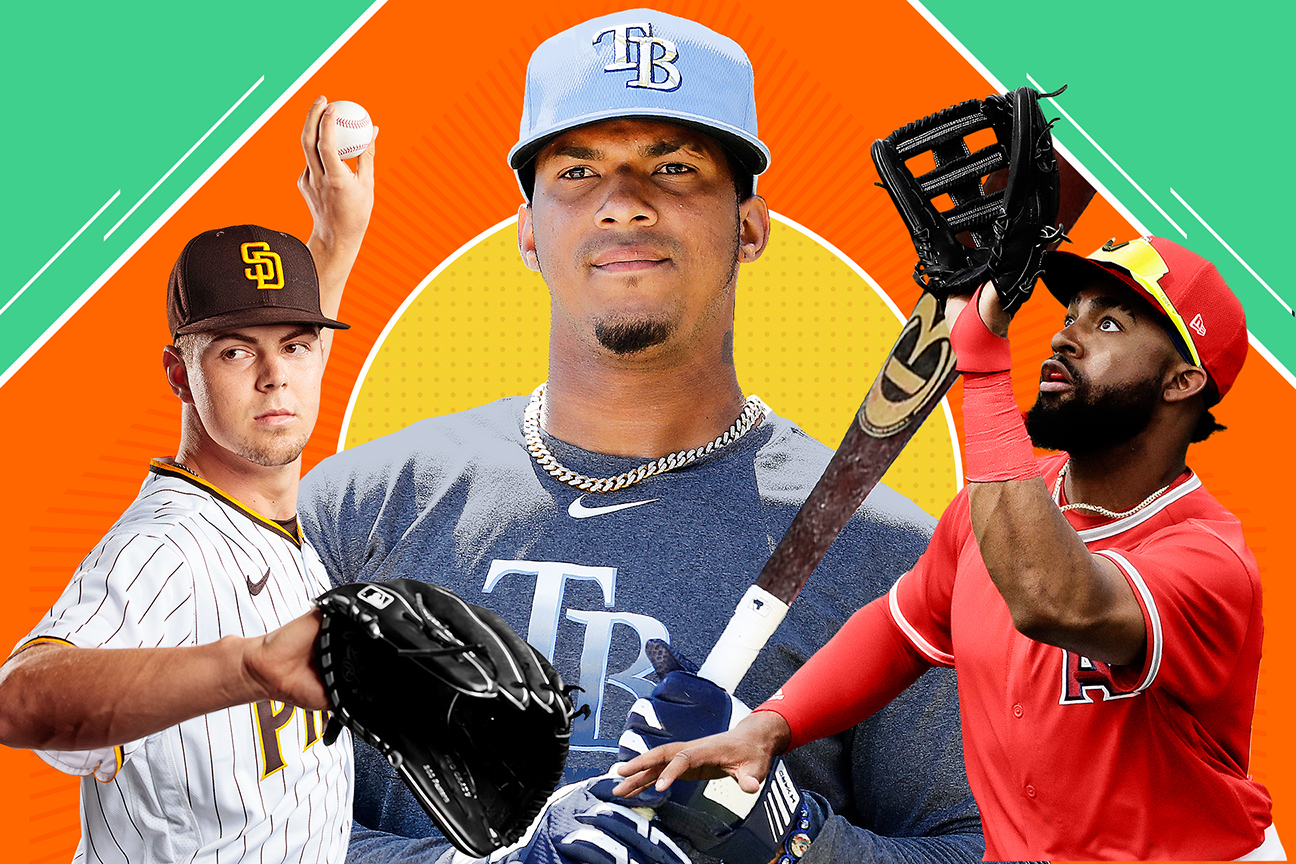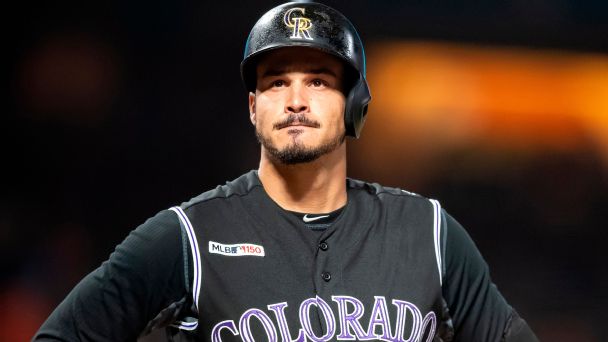It’s here. Finally. Spring training 2.0. Or make that summer camp. Or is it summer training? In any case, Major League Baseball begins its strange 2020 odyssey on Wednesday in the strangest of ways — but appropriate for the times: Testing for a virus that didn’t exist a year ago. If cleared, workouts will begin on Friday in major league ballparks across the country. Here’s what you need to know.
Jump to …
Trying to play through a pandemic | Testing regime
On-field impact, new rules | Injuries | Prospects in play
Free agents | Teams, players affected
Trying to play through a pandemic
What does a typical day at spring training 2.0 look like?
The actual workouts won’t look that different from a February or March day in Arizona or Florida except there will be only one diamond for use. That means some staggered practices, whether that’s pitchers throwing bullpens followed by batting practice or vice versa. Pitchers eventually will throw to their own hitters as the latter group tries to find its timing without playing a lot of exhibition games. When everyone is ready, there will be intrasquad games in place of those exhibition contests.
Before any of it happens, of course, players will get their temperatures checked and be tested for COVID-19 starting on their arrival day at camp and continuing every other day. Any temperature above 100.4 and they’ll be sent home.
More: ESPN Daily Podcast on MLB’s plan to restart season
How often will players be tested?
Every other day unless their temperature exceeds 100.4. Then they’ll be tested — no matter the day — and sent home. They will also be required to take their own temperatures before coming to the ballpark. Anyone with a fever will be told to stay away.
How many players are sitting out so far? Do we expect more in the days to come?
So far, Ian Desmond of the Rockies and Mike Leake of the Diamondbacks, along with Ryan Zimmerman and Joe Ross of the Nationals, have all decided to opt out of the 2020 season — without pay. Each has his own reasons, which could include a family member who is high risk or a pregnant wife. Rumors persist that there will be more players who opt out. Stay tuned.
Are there exhibition games? Intrasquad?
Teams can play up to three exhibition games at the end of summer camp. That can be against a regional opponent — like Mets vs. Yankees — or against the team they will face in the opening series of the season. Until then, it’s all intrasquad with MLB umpires overseeing them.
2 Related
Are all 30 teams at their MLB stadium or are there exceptions?
With recent COVID-19 outbreaks in Florida and Arizona, it made the decision to hold summer camp at home cities that much easier.
How will teams address fans gathering outside the ballparks?
They’ll discourage it. In some cities, that will be easy. In others, not so much. Players won’t come near the fans so the hope is there will be no point in congregating after a while. But it’s a concern.
How will umpires get ready for the season ahead?
A team of three umpires will embed themselves at each summer camp, working live bullpen sessions and intrasquad games. For the final couple of days of training, teams will play each other, bringing together six umpires for final prep before the regular season. Additionally, three minor league umpires will embed with each taxi squad and be ready in case a regular umpire is sick or injured.
On-field baseball impact
How will baseball be played differently this year?
First, there are some significant rules changes, aside from the coronavirus protocols (such as no spitting or pitchers being allowed to carry a wet rag in their back pocket to use for moisture instead of licking their fingers):
• All National League games will include the designated hitter.
• In extra innings, each team will begin with a runner on second base. The runner will be the player in the batting order immediately preceding that half-inning’s leadoff hitter (or a pinch runner).
• As previously planned, all relief pitchers must face a minimum of three batters (unless the inning ends).
• Opening Day rosters will feature 30 active players culled from each team’s 60-man player pool. The active roster will be trimmed to 28 players on the 15th day of the season and then to 26 players on the 29th day. There will be no limitations on the number of pitchers (as previously required in a new rule change). Teams will be permitted to carry three players from its taxi squads on road trips, one of whom must be a catcher.
• The trade deadline is Aug. 31; Sept. 15 is the postseason eligibility deadline.
• The standard injured lists will be 10 and 45 days and there will be a separate COVID-19 injured list for players who test positive, have a confirmed exposure to COVID-19 or exhibit symptoms requiring self-isolation.
• The schedule will be regionally based, with teams playing 40 games within the division and 20 intraleague games against the corresponding geographical division.
As for on-field strategies, some things we might see:
• Due to the short summer camp training session, starters will likely pitch fewer innings the first two or three times through the rotation. You could see things like tandem starters — two starters throwing three innings in the same game — and several teams have already announced they plan to go with a six-man rotation. The Braves are a perfect example of a team that could piggyback starters, with a deep rotation that includes Mike Soroka, Mike Foltynewicz, Cole Hamels, Max Fried, Felix Hernandez, Sean Newcomb, Kyle Wright and Touki Toussaint.
• In general, with the expanded rosters for the first month, expect to see more bullpen usage (although the three-batter rule will eliminate some of the churn). The short season and importance of every game means managers may rely more heavily on their best relievers as they won’t have to worry as much about having to keep them fresh for six months and then the playoffs. Look to see more four- and five-out saves from closers.
• The extra roster spots at the start of the season means we could see more pinch-running/defensive-replacement types used as bench players, a class of player that has largely disappeared in the past couple of decades. The extra-inning baserunner rule in particular means having a speed player on the bench would be of value.
• The bunt may not be dead! Sacrifice bunts from non-pitchers are rare these days and now pitchers won’t be batting, but the extra-inning baserunner rule could lead to some sacrifice bunting.
What are some baseball-related injuries to watch?
The big one is Aaron Judge’s cracked rib, originally suffered last September but not diagnosed until early March. He reportedly just started to hit off a tee, so we’ll know a lot more about his timetable once he reports to summer training. Giancarlo Stanton (calf strain) and Aaron Hicks also would have missed the start of the original season. Stanton should be fine while Hicks has resumed taking batting practice.

Everything you need to know about the 2020 MLB season, including key dates, rules changes and how it will all come together. Story »
60-game season predictions »
Some other injury news:
• Among those who would have missed the start of the season but should now be OK to go: Justin Verlander of the Astros (groin surgery), James Paxton of the Yankees (back surgery), Cole Hamels of the Braves (shoulder), Rich Hill of the Twins (elbow), Austin Adams of the Mariners (torn ACL), Yoenis Cespedes of the Mets (heel), Nick Senzel of the Reds (shoulder).
• Likely to miss start of the season: Mitch Haniger, Mariners (torn adductor muscle and herniated disk).
• Out for the season: Chris Sale (Red Sox), Noah Syndergaard (Mets), Luis Severino (Yankees), John Brebbia (Cardinals), Jameson Taillon (Pirates), Chris Archer (Pirates). All except Archer (who had thoracic outlet surgery) had Tommy John surgery.
• Returning from Tommy John surgery: Shohei Ohtani (Joe Maddon already said the Angels plan to start him once a week), Michael Kopech, Carlos Rodon, Corey Knebel, Jordan Montgomery.
• Suspensions: Michael Pineda of the Twins will still have to serve the full 39 days remaining on his PED suspension.
• Opting not to play because of COVID-19: Ryan Zimmerman and Joe Ross (Nationals), Ian Desmond (Rockies), Mike Leake (Diamondbacks).
Any prospects from the 60-man rosters who could actually make a difference?
I would classify prospects into two groups: 1, Players who were already close to the majors and would have been called up at some point in a normal season; 2, Players further away but who might get some time in the majors, especially with no minor league season. Aside from those rookies who have already appeared in the majors — Gavin Lux, Jesus Luzardo, A.J. Puk, Dustin May, Brendan McKay, Carter Kieboom, Nico Hoerner — here a few of the more interesting names to watch, with Kiley McDaniel’s prospect ranking in parenthesis.
Close to the majors:

Spoiler alert: Wander Franco leads our list. Which MLB stars of tomorrow follow the best prospect since Mike Trout in this year’s rankings? Kiley McDaniel (ESPN+)
• Luis Robert, CF, White Sox (No. 5). He signed a long-term deal so he should start on Opening Day.
• Nate Pearson, RHP, Blue Jays (No. 6). He turned heads in spring training with his 100-mph fastball and while he might not break summer camp in the rotation, he will be up not long after.
• Jo Adell, RF, Angels (No. 10). He did struggle in his promotion to Triple-A last year (no home runs in 121 at-bats), so he might not be quite ready to contribute.
• Matt Manning (No. 13)/Casey Mize (No. 14)/Tarik Skubal (No. 79), Tigers. The three starters could all join the rotation at some point.
• Christian Pache, CF, Braves (No. 17). The Braves have several outfield options, but could slide Marcell Ozuna to DH and play Ender Inciarte, Pache and Ronald Acuna Jr. in what would be a stellar defensive outfield.
• Forrest Whitley, RHP, Astros (No. 25). He had a lost season in 2019, but Houston’s rotation depth has thinned out with the departures of Gerrit Cole and Wade Miley.
• Dylan Carlson, OF, Cardinals (No. 28): He hit .292/.372/.542 in the minors and is still just 21, but the St. Louis outfield has some holes.
• Nick Madrigal, 2B, White Sox (No. 47): The best contact hitter in the minors (just 16 K’s in 532 plate appearances) should take over at second base.
• Sixto Sanchez, RHP, Marlins (No. 55): The prize of the J.T. Realmuto trade, the Marlins may as well see what he can do.
• Evan White, 1B, Mariners (No. 64). Like Robert, he signed a long-term deal, so he’ll be their starter from the get-go.
Further away:
• Wander Franco, SS, Rays (No. 1). He hasn’t played above A-ball and Willy Adames is a really good defensive shortstop, but maybe Franco sees some time at third base or second base.
• Joey Bart, C, Giants (No. 5). The Giants have just four catchers in their player pool and two of them are veteran minor leaguers Rob Brantly and Tyler Heineman, so Bart could serve as Buster Posey’s backup.
• MacKenzie Gore, LHP, Padres (No. 8). He has made just five starts above A-ball, but he’s polished enough to start now.
• Luis Patino, RHP, Padres (No. 11). Has logged just two starts above Class A and he’s less refined then Gore, but his fastball/slider combo could make him an effective reliever right now.
• Jarred Kelenic, CF, Mariners (No. 12). He has just 21 games above A-ball, but with Mitch Haniger injured and Mallex Smith the projected center fielder, the Mariners will consider giving Kelenic 200 at-bats.
• Spencer Howard, RHP, Phillies (No. 21). The Phillies will need rotation help.
Are there any free agents still unsigned who could make teams this spring?

Sure, the baseball season has been in limbo, but that doesn’t mean we can’t have Power Rankings. How does your team stack up? Power Rankings
Yasiel Puig is the biggest name still out there, coming off a season in which he hit .267/.327/.458 and was worth 1.3 WAR, making him a below-average regular. Ian Desmond opted out of playing for the Rockies, so Colorado appeared to be a possible destination, except the Rockies just struck a deal with Matt Kemp, who had been with the Marlins in spring training but was left off their 60-man player pool. At this point, count on the Rockies giving Sam Hilliard a chance to play with David Dahl in center field. Otherwise, teams like the Marlins, Orioles and Tigers are weak in the outfield, but Puig doesn’t really fit into a club in rebuilding mode.
Otherwise, there’s not much else of note. Scooter Gennett was a 2018 All-Star when he hit .310 with 23 home runs, but he was injured much of 2019 and hit .227 with a horrific 41-2 strikeout-to-walk ratio. He’s limited to second base, which makes him less useful as a utility player. Fernando Rodney is 43 years old and still throws hard, but had a 5.66 ERA in 2019. Tim Beckham has some power and can play all over the infield, but he’s basically a replacement-level player. Lucas Duda has two 30-homer seasons, but those are far in the rearview mirror after hitting .171 last year.
Any teams or players who may struggle (or benefit) from the delayed start of short camp?
Some teams to watch here:
• Will the Nationals benefit from the longer-than-normal break? Remembering that the Cubs struggled in the first half in 2017 and how the Red Sox got off to a terrible start in 2019, maybe the Nationals won’t have a similar World Series hangover, especially the starting rotation that pitched all those additional high-intensity innings in the postseason.
• Does the Astros’ sign-stealing baggage go away? And keep an eye on Verlander, who had a lat strain in early March, but has been a hot starter the past two seasons, with an ERA of 1.70 through the first 60 games of the season. Alex Bregman, on the other hand, has been a slow starter, with a career .765 OPS in April but at least .894 in every other month.

The Rockies star shares what his game days were like, but how he has to spend them now during a pandemic. Story »
• The Phillies would love Bryce Harper to get off to one of his patented hot starts. His 1.025 OPS in March/April is eighth highest of all time. He has an .872 OPS in all other months.
• The Reds and White Sox had the most active offseasons, but the Reds now will have no game action to sort out a crowded outfield picture (Nick Castellanos, Nick Senzel, Jesse Winker, Shogo Akiyama, Phillip Ervin) that won’t include Aristides Aquino, who wasn’t included in their player pool. The White Sox will test the health of Kopech and Rodon, but rookies Robert and Madrigal will have less of the traditional spring training action to get ready to face big league pitching.
• The Padres are a popular “surprise” pick, but have to determine how some of the young pitchers, such as Gore and Patino, fit into their plans. They need to figure out an outfield that includes just one lock in Tommy Pham, with Trent Grisham, Wil Myers, Franchy Cordero and Josh Naylor fighting for playing time.
Which teams might excel or struggle due to the nature of the season?
Let’s look at it this way. If the theory that pitching depth is even more important than normal — especially bullpen depth — some ways that may play out:
• The Rays led the majors in both bullpen innings and ERA (3.66) last season. While they’ll probably ditch the opener this year, they not only have a great trio in Charlie Morton, Blake Snell and Tyler Glasnow in the rotation but an envious list of high-powered arms to relieve them.
Baseball is back, and so is fantasy! Get the gang back together, or start a new tradition.
Everything you need to compete >>
• The Yankees’ ranked just ninth in bullpen ERA, but their top four of Aroldis Chapman, Zack Britton, Adam Ottavino and Tommy Kahnle are as good as anybody’s.
• The Dodgers may have some bullpen issues, but like the Braves they could benefit from piggybacking starters early on. They did lose Hyun-Jin Ryu to the Blue Jays and traded Kenta Maeda, but still have Clayton Kershaw, Walker Buehler, David Price, Julio Urias, Alex Wood, Dustin May, Tony Gonsolin and Jimmy Nelson.
• The Rangers could have an excellent rotation with Corey Kluber, Jordan Lyles and Kyle Gibson joining Mike Minor and Lance Lynn.
• The Nationals won the World Series despite the worst bullpen ERA in the majors (5.66). They signed Will Harris from the Astros, but this could still be an issue.
• The Cubs lost Hamels and are relying on four starters in their 30s and a comeback from closer Craig Kimbrel, with little depth in reserve.
• The Phillies add Zack Wheeler as a free agent, but rank just 18th in projected rotation WAR and 21st in bullpen WAR (via FanGraphs). Even if Howard can have an impact, the depth is shaky in what should be a tough division.
Credit: Source link


